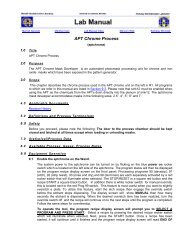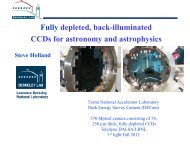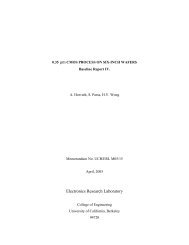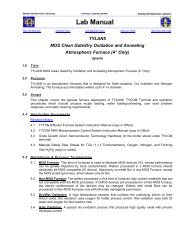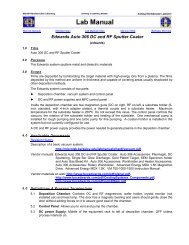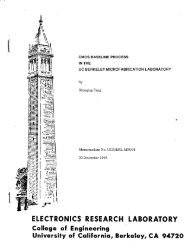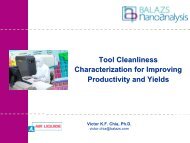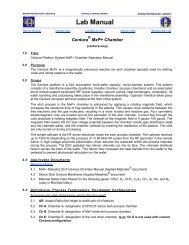Chapter 5.15 - Tystar15 LPCVD Furnace (6") - Berkeley Microlab
Chapter 5.15 - Tystar15 LPCVD Furnace (6") - Berkeley Microlab
Chapter 5.15 - Tystar15 LPCVD Furnace (6") - Berkeley Microlab
You also want an ePaper? Increase the reach of your titles
YUMPU automatically turns print PDFs into web optimized ePapers that Google loves.
Marvell Nanolab Member login Lab Manual Index Mercury Web <strong>Berkeley</strong> <strong>Microlab</strong><br />
1.0 Title<br />
<strong>Tystar15</strong> <strong>LPCVD</strong> <strong>Furnace</strong> (6”)<br />
(tystar15)<br />
<strong>Tystar15</strong> — Non-MOS <strong>LPCVD</strong> Polycrystalline Silicon Carbide<br />
2.0 Purpose<br />
<strong>Tystar15</strong> is used to deposit polycrystalline silicon carbide (poly-SiC) films, doped with nitrogen or undoped.<br />
It can process both 4- and 6-inch wafers.<br />
3.0 Scope<br />
This chapter covers the general furnace description of TYSTAR 15, TYCOM and furnace operation<br />
procedure, which includes process recipe loading, wafer loading/unloading, process status monitor,<br />
user level problem diagnosis, and wafer cleaning requirements.<br />
4.0 Applicable Documents<br />
Revision History<br />
4.1 <strong>Chapter</strong> 5.0 of lab manual (Tystar/Tylan <strong>Furnace</strong>s - Overview).<br />
4.2 Material Safety Data Sheets for 1,3-Disilabutane (DSB), Dichlorosilane (DCS), Ammonia (NH3)<br />
and Nitrogen (N2) (copies in Lobby).<br />
5.0 Definitions & Process Terminology<br />
5.1 Non-MOS Tube: <strong>Tystar15</strong> is a general/MEMS use type fabrication furnace (Non-MOS).<br />
5.2 1,3-Disilabutane (DSB; CH3SiH2CH2SiH3): A gas used in our poly-SiC (doped & undoped)<br />
processes.<br />
5.3 Ammonia (NH3): A gas used to dope the polysilicon carbide film.<br />
5.4 ROP: Remote-Operation Panel.<br />
5.5 ALMACK: Alarm Acknowledge is a button used to proceed to next step in recipe.<br />
5.6 ABORT: This key can be used to abort the process. This is commonly used for unloading the<br />
wafers, where users invoke the recipe again, after run has been completed and properly vented.<br />
The tube will open for the users to unload their wafers followed by abort to load the standby<br />
recipe, and before leaving the area.<br />
Machine Interlock Messages<br />
5.7 ANTLK: Above atmosphere interlock, no process gas can flow (including N2).<br />
5.8 BNTLK: Below process pressure interlock, no process gas can flow.<br />
5.9 DNTLK: Door interlock, door is not closed; no process gas can flow.<br />
5.10 GNTLK: Gate valve interlock, gate valve is not open, no process gas can flow.<br />
5.11 VNTLK: Vacuum interlock, pump problem, no process gas can flow.
tystar15 <strong>Chapter</strong> <strong>5.15</strong><br />
6.0 Safety<br />
Follow general safety guidelines in the lab as well as the specific safety rules as per follows:<br />
6.1 <strong>Tystar15</strong> utilizes potentially hazardous gases and high electric power (high amperages to heat its<br />
elements). Do not open the front or the back panels, as it can expose you to high power circuitry.<br />
6.2 Special care must be taken when the tube is aborted and while in deposition step. The toxic<br />
process gases present will need to be properly vented. This can be accomplished by<br />
acknowledging out of flush & hold steps of the standard recipes. In an emergency situation<br />
(earthquake, fire) the process can be aborted. Make sure toxic gases are properly vented by a<br />
series of pump and purges and by running the 15purge recipe. Ask process staff if you need help<br />
or if you have any questions in this regard. Do not alter any of the standard processes and<br />
specially do no skip any important purge or vent step in your recipes.<br />
6.3 All new recipes have to be checked by process staff, before they can be used on any of our Tylan<br />
or Tystar furnaces.<br />
6.4 This tube is a dedicated poly-SiC tube, and process temperatures are in the typically around<br />
800ºC. Do not run the tube at temperatures above 835ºC, as it may crack the tube, which has<br />
thick poly-SiC deposited on its walls, and under stress and damage the door seal).<br />
7.0 Statistical/Process Data<br />
Pertinent information can be found on the following sites:<br />
7.1 Process monitoring test section of the <strong>Microlab</strong>’s home page.<br />
7.2 Problem and comments section under equipment section of the wand.<br />
7.3 Enable message for <strong>Tystar15</strong>.<br />
8.0 Available Processes & Gases<br />
<strong>Tystar15</strong> tube is assigned to standard doped and undoped poly-SiC processing.<br />
8.1 Standard undoped poly-SiC process: For standard undoped poly-SiC films, the variable poly-SiC<br />
recipe 15VDSICC should be used with the following input conditions: DSB = 45, DCS = 20, NH3<br />
= 0, T = 800, P = 170.<br />
8.2 Standard doped poly-SiC process: For standard doped poly-SiC films, the variable poly-SiC<br />
recipe 15VDSICC, should be used with the following input conditions: DSB = 43.6, DCS = 19.4,<br />
NH3 = 2, T = 800, P = 170.<br />
8.3 Variable doped Polysilicon carbide process: The variable doped poly-SiC recipe 15VDSICC,<br />
allows for the user to vary the gas flowrates (DSB, DCS, and Ammonia) as well as process<br />
pressure and deposition temperature.<br />
8.4 This tube is calibrated in the temperature range of 650ºC – 835ºC. Do not attempt to run any<br />
processes outside of this temperature range. Especially, process temperatures above 835ºC are<br />
not allowed. This could crack the tube and damage the door seal.<br />
8.5 Available gases on this tube are DSB, DCS, NH3, Methyl Silane, H2, N2, N2VAC, and N2PRG.<br />
9.0 <strong>Furnace</strong> Operation<br />
9.1 Control Key Description<br />
Many of the operational commands can be executed from ROP. Function keys such as Recipe,<br />
Run, Hold, Clock, Status, and more are also available. Appendix 1, at the end of this chapter,<br />
displays all these function keys. There are two ALMACK keys available on the ROP. The one on<br />
the far right side just above the ABORT key is the main one to use.<br />
- 2 -
tystar15 <strong>Chapter</strong> <strong>5.15</strong><br />
9.2 Operational Procedure/Guidelines<br />
Recipes can be loaded from TYSTAR15 recipe diskette and Tycom terminal. Run your process.<br />
Take your wafers out, after your process is completed. Note: You will need to wait for the boat to<br />
completely go back in before you can load the standby recipe. This means, once you find your<br />
run completed, ALMACK twice out of the flush & hold step, then run the recipe again, get your<br />
wafers out (this takes about 12 minutes). Then, ALMACK through the unload step to send the<br />
boat in and make sure the door is completely closed, before you ABORT the process. Finally,<br />
load the standby recipe. Note: Aborting the tube before the boat-loading step is completed, stops<br />
the boat loader in its track with the door open.<br />
9.2.1 Recipes<br />
<strong>Tystar15</strong> recipes are residing on a dedicated diskette marked as <strong>Tystar15</strong>. These<br />
recipes have a standard format with three pump and purge cycles before and after the<br />
deposition step. This is designed to better control the film particles by keeping the tube<br />
cleaner. There is a variable doped poly-SiC recipe available on <strong>Tystar15</strong> disk, as well as<br />
standby, vent and purge recipes. The vent and purge recipes are designed to speed up<br />
recovery process.<br />
See Appendix 2 for more details on the available recipes.<br />
15VDSICC Recipe: Variable doped poly-SiC recipe (var.DSB, DCS, NH3,<br />
pressure, temperature)<br />
15STNBYA Recipe: Standby recipe to be used, post poly-SiC deposition.<br />
15PURGE Recipe: Additional recipe available to purge and vent the tube.*<br />
15VENT Recipe: Additional recipe available to vent the tube.*<br />
* Note: The vent and purge recipes can be used for quick vent or pump/purge cycles.<br />
The abort, as you know, takes the recipe back to its first step. This may take a<br />
long time for the tube to vent. This is because the initial step bleeds only about<br />
one liter of nitrogen into the tube, in which case it takes a long time to bring the<br />
tube to atmosphere. This can be accomplished much faster by loading one of<br />
the two recipes noted above. However, take extreme care and make sure that<br />
you do not use the vent recipe when harmful gases are present (abort at<br />
deposition step). Load the purge recipe instead. This can come handy when<br />
the abort has occurred, while still in deposition step or if the origin of the abort<br />
sequence is not known (did it abort at deposition step?).<br />
9.2.2 Recipe Modification and New Recipe Generation<br />
As always, modification to standard recipes is not allowed. There is 15VDSICC<br />
recipe available on the TYSTAR15 diskette for users to vary the process parameters.<br />
Talk to process staff if you need to develop other recipes.<br />
9.2.3 Recipe Loading<br />
Type LO followed by recipe name and 15 to load the recipe onto the tube from<br />
Tycom terminal. e.g. LO 15VDSICC 15.<br />
9.2.4 Running Recipe<br />
Once the recipe is loaded you can type RU followed by tube number (15) or simply<br />
press run button on the ROP terminal.<br />
9.2.5 Wafer Loading<br />
Once the boat is out, replace dummy wafers with your work wafers. There is a 20<br />
minutes window available for this task. Once the 20 minutes elapses, the boat loader<br />
- 3 -
tystar15 <strong>Chapter</strong> <strong>5.15</strong><br />
will automatically go in. Do not worry, simply ALMACK through to cycle back to boat<br />
unload step and wait for the boat to come out. You have another 20 minutes to load<br />
your wafers.<br />
9.2.6 Opening and Closing DSB Source Valve<br />
DSB is expensive and therefore a manual valve is installed as a precautionary<br />
measure against slow, but appreciable leaks. The valve is located in the grey DSB<br />
source cabinet in the Tylan service chase. This valve must be opened after wafers<br />
are loaded and before the deposition step. The valve must be closed after the<br />
deposition step and before disabling the system on the WAND. After closing the<br />
valve, mark the remaining DSB level on the DSB source ampoule. (Note that there<br />
are two ampoules in the cabinet. The one on the right is filled with DSB for member<br />
use. If it is empty, report as a fault.)<br />
9.2.7 Unloading Wafers<br />
Once the process is completed the furnace will wait in flush & hold step. You will<br />
need to ALMACK twice out of this step to vent the tube. You will need to run the<br />
recipe again so that the boat loader will bring the tube out. You will then need to<br />
ALMACK to send the boat in and wait for the door to completely close. You can then<br />
abort the process and load the standby recipe, before signing off.<br />
9.2.8 Standby Recipe (finishing up)<br />
10.0 Troubleshooting Guidelines<br />
10.1 Failed Leak Check<br />
Once your run is completed and your work wafers are out, you will need to load & run<br />
the standby recipe, 15STNBYA<br />
10.1.1 Check the machine status screen on the Tycom terminal (type in DI ST 15).<br />
10.1.1.1 If GNTLK or VNTLK is ON, stop and report it as fault.<br />
10.1.1.2 If DNTLK is ON, vent the tube. Run the process again. Try this a couple of<br />
times, if necessary. Report as fault, if it still fails. There may be door sensor<br />
problems.<br />
10.1.1.3 If no interlock is ON, vent the tube, wipe the door and the o-ring. Run the<br />
process again, and if it still fails, report it as fault.<br />
10.2 No Process Gas Flow<br />
10.2.1 Check the machine status screen on the Tycom terminal (type in DI ST 15).<br />
10.2.1.1 If any interlock is ON, report it as fault.<br />
10.2.1.2 Check the appropriate gas cylinder, if empty report as fault.<br />
- 4 -
tystar15 <strong>Chapter</strong> <strong>5.15</strong><br />
11.0 Appendices<br />
11.1 Polysilicon – Tube 15<br />
- 5 -
tystar15 <strong>Chapter</strong> <strong>5.15</strong><br />
11.2 Recipes<br />
15VDSICC<br />
Step Description Time<br />
01<br />
05<br />
10<br />
15<br />
20<br />
25<br />
30<br />
35<br />
40<br />
45<br />
50<br />
55<br />
60<br />
65<br />
70<br />
75<br />
80<br />
85<br />
90<br />
95<br />
100<br />
105<br />
110<br />
115<br />
120<br />
125<br />
130<br />
135<br />
140<br />
145<br />
150<br />
155<br />
Initialize<br />
Boat Out<br />
Load/ Unload Wafers<br />
Load boat<br />
Check dntlk<br />
Pump1<br />
Purge1<br />
Pump2<br />
Purge2<br />
Pump3<br />
Leak check<br />
Set temp (variable)<br />
Temp stabilize<br />
Check temp profile<br />
Pump4<br />
Flow gases (variable gases allowed)<br />
Pressure set (variable)<br />
Deposition step (Time Var.)<br />
Reset temp to 450ºC<br />
Pump1<br />
Purge1<br />
Pump2<br />
Purge2<br />
Pump3<br />
Check if process fail<br />
Postdep standby<br />
1 st almack branch<br />
loop back to standby<br />
2 nd almack branch<br />
Backfill-1<br />
Backfill-2<br />
End<br />
15STNBYA<br />
Step Description Time<br />
01<br />
05<br />
10<br />
15<br />
20<br />
25<br />
30<br />
35<br />
40<br />
45<br />
50<br />
55<br />
60<br />
Initialize<br />
Load<br />
Check door closed<br />
Short pump<br />
Degas purge<br />
Hard pump<br />
Leak check<br />
Standby<br />
Branch to back fill1<br />
Loop back to standby<br />
Backfill-1<br />
Backfill-2<br />
End<br />
- 6 -<br />
N/A<br />
10 min<br />
10 sec<br />
2 min<br />
10 min<br />
2 min<br />
1 min<br />
1 hr<br />
5 sec<br />
1 sec<br />
5 min<br />
8 min<br />
N/A<br />
10 min<br />
20 min<br />
10 min<br />
10 sec<br />
2 min<br />
2 min<br />
2 min<br />
2 min<br />
2 min<br />
1 min<br />
20 min<br />
5 min<br />
5 min<br />
2 min<br />
30 sec<br />
30 sec<br />
Variable<br />
5 sec<br />
2 min<br />
2 min<br />
2 min<br />
2 min<br />
2 min<br />
0<br />
0<br />
5 sec<br />
5 sec<br />
5 sec<br />
5 min<br />
7 min



